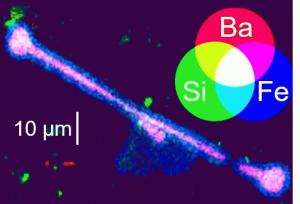Carcinogenic asbestos in human lungs
Asbestos from asbestos plants, mines, and products is currently a major environmental health threat. In fact, due to the weathering and degradation of asbestos products, which were largely used as insulating, fire-resistant, and inert material, or in fiber-reinforced cement, this threat is not limited to asbestos workers, but has nowadays become a major concern also for the general population, especially in urban areas, where the density of asbestos products is higher.
The aim of this research is to reveal the fine compositional structure of the coating developing around asbestos fibers after prolonged stay in the lungs, which is believed to trigger a chain of events that can lead to mesothelioma, an aggressive cancer of the lung lining, and to lung cancer. Cutting-edge synchrotron radiation fluorescence and imaging microtomography will be combined with scanning and transmission electron microscopy to reveal the elemental distribution and morphology of unaltered lung tissue samples with unprecedented level of detail, preserving their tridimensional structure. An innovative collaboration between physicists, chemists, doctors, and biologists will create an environment favourable for breaking-through results. The methodologies developed during the project can be extended to the study of other toxic particulate, such as vehicular or industrial particulate matter and man-made nanoparticles, which are of increasing concern for human health.
This research is funded by the European Commission (BiominAB-3D, Marie Sklodowska-Curie IF action, H2020).

X-ray fluorescence map of an asbestos body (i.e. an asbestos fiber with its Fe- protein coating) extracted from human lung tissue and analyzed at the European synchrotron (ESRF) in Grenoble (France) at 7.3 keV (pixel size 0.5x0.5 μm2). The distribution and co-localization of Ba, Si, and Fe is highlighted by RGB color combination.
References
[1] Price, B. and Ware, A. Mesothelioma trends in the United States: an update based on Surveillance, Epidemiology, and End Results Program data for 1973 through 2003. Am. J. Epidemiol. 159, 107-12 (2004).
[2] Governa, M. and Amati, M. Role of iron in Asbestos-Body-induced oxidant radical generation. J. Toxicol. Environ. Heal. Part A 58, 279-287 (1999).
[3] Bardelli, F. et al. New insights on the biomineralisation process developing in human lungs around inhaled asbestos fibres. under review.
Collaborators
Department of Earth Sciences, University of Torino (Italy)
Institute of Earth Sciences (ISTerre), University of Grenoble Alpes (France)
ID17 beamline at the European Synchrotron Radiation Facility (France)
